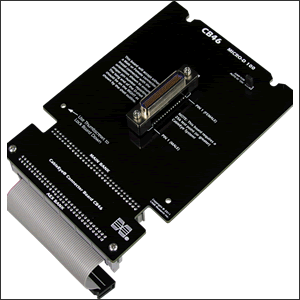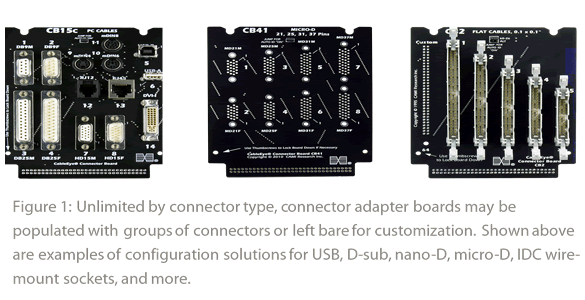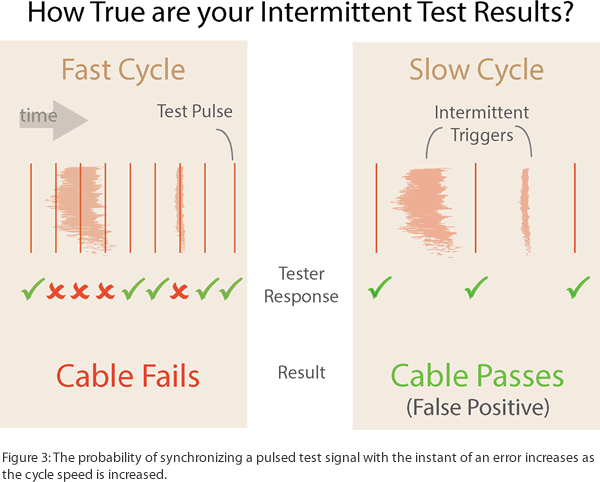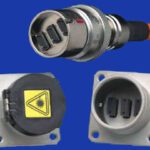Diagnose Fatigue-Induced Failure in Cables in Motion
A major concern in robotics applications, cables in motion experience fatigue that can cause failures whether or not that motion is constant. Cable and harness test systems can help identify the source.
 Cables in motion experience fatigue that can cause complete or intermittent failures, whether or not that motion is constant. Cable and harness test systems can easily identify and pinpoint the source of even the most elusive intermittent failure.
Cables in motion experience fatigue that can cause complete or intermittent failures, whether or not that motion is constant. Cable and harness test systems can easily identify and pinpoint the source of even the most elusive intermittent failure.
Flexibility
Cables may flex intentionally as part of a pre-programmed robotic move or unintentionally due to operationally or environmentally induced vibration.

The most flexible test systems are backed by a large library of test boards that, for robotics applications, includes compatibility with, for example, nano- and micro-D connectors. For optimal flexibility and usability, these boards are mounted with families of connectors or connector slots (figure 1). This is an especially agile and economical methodology, much appreciated by contract manufacturers and other companies where fast reconfigurability is necessary.
Such flexible cable and harness test systems may be used for all robotic applications, whether industrial or service (e.g. personal, military, medical, logistic).

Pre-Installation
Faults such as bad crimps, broken wires, and cold solder joints will result in intermittent connections. The issue is whether test equipment is sufficiently sensitive to detect them and whether the test is applied at the earliest possible point in the value-added stream; the earlier the testing, the less the impact of any detected error.
Those who buy connectorized cables for robotic applications will want to ensure their suppliers are shipping cables that have passed intermittent testing under fast cycle times. In this context, a full cycle comprises a complete sweep through all test points.
The Intermittent Test
The intermittent test is properly performed when the sample rate is high enough to statistically capture enough random events to raise the confidence level in the test result to an acceptably high degree. Companies running stringent quality programs (such as Six Sigma) will be looking for the fastest cycle time possible. They need testers that deliver diagnostic information above a simple pass/fail, so they can provide quantitative and qualitative data to their process-improvement feedback loop.
Note that although the intermittent test mode is often referred to as the “continuous test,” the test signal itself is always pulsed in order to sweep through the full set of test points. In this context, “continuous” simply means that the test is continuously sweeping through these test points.
Testers are available ($1295+) that will sample 128 test points with 100ms/cycle time using tester default settings, and as fast as 11ms/cycle by reducing both dwell time (to zero) and the number of test points. Even faster speeds can be achieved by adjusting other parameters. These same testers include a dynamic GUI for identifying the type and location of the intermittent error (figure 2) and can output ISO 9000-quality printed reports that include the same graphics.
The probability of synchronizing a pulsed test signal with the instant of an error increases as the cycle speed is increased. In figure 3, we illustrate how a tester may deliver a false “pass” if its sample rate cannot be set high enough to capture the moment of error. In figure 2, we see that in 434 attempts (i.e. 434 full test cycles), six errors were captured at 100ms/cycle while the cable under test was being flexed. If the sample speed had been set any slower, there would have been a high likelihood that this cable would have falsely passed the intermittent test. Care must be taken when setting test parameters to avoid such false positives.
To achieve the necessary sample rates, resistance measurements are not part of the intermittent test, and only opens and shorts are reported.

Ideally, an intermittent fault tester will permit testing at two thresholds in order to accommodate cables that have integrated resistive components. These types of cables may be tested in two stages. At the lower threshold, any line containing an integrated resistive component will deliver an “open” error. Testing again at a threshold set above the known resistance of the integrated component is necessary to isolate whether or not there is a true open fault on that line.
Post-Installation
 Cable diagnostics on failed integrated robotic systems can be approached in several ways. If removal of each cable in turn for testing is not feasible, testing may be performed in-situ, using “full” or “loop” test protocols. For mobility, the tester itself may be on a mobile cart, even rack-mounted with your other diagnostic equipment, and operated with a touchscreen laptop (figure 4):
Cable diagnostics on failed integrated robotic systems can be approached in several ways. If removal of each cable in turn for testing is not feasible, testing may be performed in-situ, using “full” or “loop” test protocols. For mobility, the tester itself may be on a mobile cart, even rack-mounted with your other diagnostic equipment, and operated with a touchscreen laptop (figure 4):
- In-situ full test – Disconnect each end and attach adapters between each end of the cable and the tester. Execute the intermittent test while the robot performs the motion that flexes the cable.
- In-situ loop test – This is a two-step test that is often used when cables are very long, but may be applied to short cables in instances where the cable can neither be uninstalled nor is there room for fixtures at the far end. In step one, with both ends disconnected, a shorts test is performed at one end. Continuity testing is carried out in step two after applying jumpers to pairs of pins at the far end. At each step, after learning the cable set-up, an intermittent test will be carried out while the robot is performing the motion that flexes the cable. Using a macro feature that comes with the tester, the entire loop test sequence can be readily automated, simplifying the diagnostic test for the operator.
For mission-critical robots in particular, the quality control team will want to create a maintenance schedule that includes testing for intermittent errors. Testing over extended durations is important for electrical-life testing of cables that undergo motion.
Cables in motion experience fatigue, which causes complete or intermittent failures whether or not that motion is constant. We have seen that cable and harness test systems can easily identify and pinpoint the source of even the most elusive intermittent failure. Beyond continuity and resistance tests, some diagnostic considerations for cables in motion are:
- Test for intermittent faults.
- Test early in the workflow, ideally at your supplier’s site.
- Use a fast-enough intermittent test cycle to provide statistically significant sampling.
- Mission-critical robots require a post-installation maintenance schedule that tests for intermittent errors.
This article was contributed by CAMI Research.





